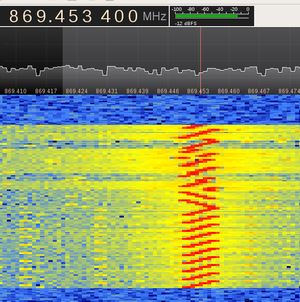EncodingLora
| Project EncodingLora | |
|---|---|

| |
| Status | In progress |
| Contact | bertrik |
| Last Update | 2016-05-17 |
This page is about synthesizing a LoRa signal such that it can be "played" back using a software-defined-radio with transmit-capabilities. This should help further in understanding the structure of the LoRa modulation, see also my other page DecodingLora. The desired end result is that the transmitted LoRa signal is compatible with and can be received with existing LoRa hardware.
Basic ideas:
- we're creating a stereo WAV-file that represents the I and Q components of the complex baseband radio signal.
- this WAV-file should have the right properties for being played back in GnuRadio using Tx-capable SDR like the Ettus B210, HackRF or the Rad1o
- initially the focus is on just generating a "LoRa-like" signal, consisting of a valid preamble (with sync pattern) but with pseudo-random (invalid) data. This should be good enough to be used as an interferer signal in studies about the robustness against interference from other LoRa devices.
- I'm planning this as a signal processing chain consisting of several blocks in series, very much how GnuRadio works. I'll probably be writing this in C or Java because these are the languages I'm most familiar with. Maybe later I can port this to the GnuRadio framework.
Next steps:
- create initial software to synthesize the basic sweeps and write them as a WAV-file, starting with a software numerically controlled oscillator block to generate the sweeps.
- play back the WAV file on an SDR and verify the generated waveform to validate the principle.